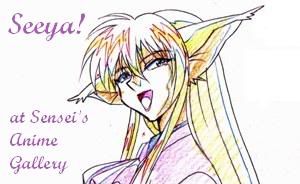I'm still having a hard time figuring out exactly what a "cut" is in animation. To me, it seems like each time there's a perspective change, that change marks the end of one cut, and the start of the next. When I try to count cuts based on what production art I either have or have seen, I often find my counting doesn't jive.
I just don't think I understand cuts properly. They sometimes seem like they might end in odd places.
I've got an example video, from Episode 2 of Azumanga Daioh. I count it as two cuts, but I'm not sure where the boundary between them is. Does the first cut end as soon as the perspective shifts from Osaka by herself, or does the first cut continue until Osaka stops talking?
https://drive.google.com/open?id=17aIV7 ... ku2yQKlHpa
Incidentally, the girl on the far right when perspective switches, I'm not sure but I think that's Chihiro. She seems like a sweet kid, but she isn't shown all that much much.
Still trying to understand "cuts".
- sensei
- Moderator and Admin-in-waiting

- Posts: 4997
- Joined: Fri Oct 01, 2004 6:55 am
- Location: Cephiro
- Contact:
Re: Still trying to understand "cuts".
One problem is that some studios consider all the images of a given character from a single perspective as one cut and give all the images in the series the same cut number. Even if this is interrupted in the middle (sometimes more than once) by a shift to another character. Tenshi ni Narumon is one example, and it's sometimes confusing when the character makes the same move twice, once before the break and then once again after. (Cut 43 in Step 26 is a famous example.) But other studios considered a cut to end every time the perspective shifted to a different character or to a different angle, even if the action was worked out as a whole by a single key animator and the sequence of douga numbers continued.
I recently got an extreme example from Asatte no Houkou, which was done by J. C. Staff, the same studio that did Azumanga Daioh. At the beginning of Ep. 1 we see Karada-chan, the cute little girl who's the protagonist (and magically becomes a grown woman as the story develops), kneeling at a roadside shrine that grants wishes. She turns to her left and smiles at the stranger who's stopped by. That's Cuts 10 and 12 according to the timing sheet because at one point the perspective shifts to the stranger, then back to Karada. The douga numbers run unbroken from A1 to A20.
Then at the very end of the episode, Karada returns to the shrine, now distressed by something that's happened that day. It's no longer day but night, and she is now wearing a different outfit. Again she turns slightly to her left, and while in Cuts 10 + 12 she's smiling, now she's visibly been crying. That's Cut 274. But because it was animated from the same angle as in Cuts 10 + 12, it starts at A21 and runs to A32 END. And all the keyframes and dougas came together in the same sketch pack.
Confusing, no? But there is a method: all the images in a single sequence seen from the same perspective are animated by the same artist in one job, and so on some level they are considered part of the same cut even if it's broken up by shifts to other perspectives. Some studios keep the same number, others change the number every time the perspective changes.
I recently got an extreme example from Asatte no Houkou, which was done by J. C. Staff, the same studio that did Azumanga Daioh. At the beginning of Ep. 1 we see Karada-chan, the cute little girl who's the protagonist (and magically becomes a grown woman as the story develops), kneeling at a roadside shrine that grants wishes. She turns to her left and smiles at the stranger who's stopped by. That's Cuts 10 and 12 according to the timing sheet because at one point the perspective shifts to the stranger, then back to Karada. The douga numbers run unbroken from A1 to A20.
Then at the very end of the episode, Karada returns to the shrine, now distressed by something that's happened that day. It's no longer day but night, and she is now wearing a different outfit. Again she turns slightly to her left, and while in Cuts 10 + 12 she's smiling, now she's visibly been crying. That's Cut 274. But because it was animated from the same angle as in Cuts 10 + 12, it starts at A21 and runs to A32 END. And all the keyframes and dougas came together in the same sketch pack.
Confusing, no? But there is a method: all the images in a single sequence seen from the same perspective are animated by the same artist in one job, and so on some level they are considered part of the same cut even if it's broken up by shifts to other perspectives. Some studios keep the same number, others change the number every time the perspective changes.
Re: Still trying to understand "cuts".
I knew something was strange when I couldn't count cuts straight through. Ah, the joys of animation. 
What about YJ sellers? Would they consider the Osaka-only portion the entirety of the cut they are selling?
What about YJ sellers? Would they consider the Osaka-only portion the entirety of the cut they are selling?
